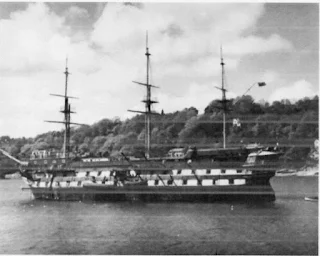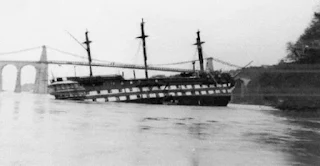THE LOSS OF HMS CONWAY
THE LOSS OF HMS CONWAY
During the early morning of 14th April 1953, HMS Conway, a large 19th century wooden battleship used for the training and education of cadets, all hoping to become officers in the Merchant and Royal Navy, was driven ashore and wrecked by some exceptionally strong tides, and eventually broke her back in the Menai Strait.
Archive report by Don Hale.
This in fact, was the second attempt to move such a large and difficult ship from her relatively safe berth at Bangor, and head back to Birkenhead for a refit. A similar attempt the day before had been aborted due to extreme difficulties, and the assessment that it was always going to be a ‘great risk.’
HMS Conway was considered to be the largest ever ship to attempt to pass through this notoriously demanding stretch of swirling waters known as the ‘Swellies, that separates Anglesey from the mainland, and included a challenging passage under two major bridges.
The vessel had an enormous draft of 22 feet, combined with a restricted clearance of just three feet under the Menai Suspension Bridge - therefore, it was never going to be an easy task – especially as the whole operation was witnessed by hundreds of curious and enthusiastic spectators!
Remarkably, even to this day, the whole incident is still surrounded by controversy, with many experienced mariners claiming they had predicted this disaster. Admiralty officials however, said they had heard these same claims before, some 12-years earlier, when the ship had first left her moorings in the Sloyne, off Rock Ferry on the River Mersey.
Ironically, HMS Conway had then been moved to North Wales for her own safety, following several near misses during heavy WW2 air raids.
The ship’s Captain at that time, Superintendent Goddard, who was an experienced hydrographical surveyor, knew of the potential dangers of this particular journey, but claimed that after studying the problem, he believed it was possible.
He said he urgently needed more shore space for training purposes, due to demand for wartime Merchant Navy cadets. She was eventually moved under a unique ‘cloak and dagger’ operation - much to the great surprise and delight of local residents who recalled seeing a massive ‘wooden wall’ coming up the Strait.
Fortunately on this occasion, the ship achieved a successful voyage, and was moored by Bangor Pier. It was a popular move and the school developed new shore facilities at Plas Newydd, the home of the Marquis of Anglesey.
After the journey, a relieved Captain Goddard said: “I was glad when it was accomplished,” and later added: “It created a lot of interest amongst the North Wales seafaring fraternity – who had declared the undertaking to be a foolish one.”
Just over a decade later however, these very words must have come back to haunt many Admiralty officials.
At precisely 8.15am on Wednesday 14th April 1953, HMS Conway began her final and very short journey. And allegedly ignoring the advice of local pilots, who warned that such a large ship should never have been taken through such a narrow and dangerous passage, navy officials finally set sail for Birkenhead.
In a Radio 4 programme called ‘Making History,’ it was later claimed that HMS Conway was a ‘dead ship’ pulled by two tugs, but sheered off and ran aground onto rocks that eventually broke her back.
The programme notes said that a Richard Jones had since made a detailed study of the loss. And incredibly added that both his grandfather and great grandfather - who were pilots at that time – were present, with one aboard the Conway, and the other aboard a tug. He claimed their advice was not taken.
Other historical documents indicate that a new ship’s Captain, Superintendent Hewitt, was in command on that fateful day, together with two local pilots, and another from Liverpool. Several volunteer cadets also manned the ship.
Two tugs, the Dongarth and Minegarth were placed at the bow and stern of HMS Conway, but it was said the timing of the movement was critical, and later claimed that another five minutes could have made a huge difference.
There was however, very little room for error, with tidal flows continuing for some time even at high water, and slack water times appearing very brief. Official reports supported these claims, confirming that an ‘unexpectedly strong current’ was encountered as the ship passed between the two bridges and the front tug found itself unable to make headway.
A decision was taken to bring the rear tug to the bow to help, leaving the stern of the ship out of control. Valuable time was lost and the ship said to have become less controllable. The stern then started to swing back and forth and unfortunately she ran aground on the ‘Platters,’ a series of flat rocks below Menai Bridge.
Several attempts to pull her off failed, and as the tide went out, she broke her back. An inspection prior to the next high tide confirmed that several of her main timbers had shattered - with some decks crushed to just a few feet. Much of the interior was salvaged but the ship rapidly became a total loss.
She was abandoned by the Admiralty, who left the local council to try to dispose of the wreck. The ship remained a desolate sight stranded on the banks of the swirling Straits for about four years before becoming the victim of a mysterious fire, which totally gutted the vessel to the waterline.
The school was later re-housed in old British Army tents and a hutted area at Plas Newydd. It was close to a former wartime site previously occupied during the Second World War by the American Intelligence Corps.
HISTORY OF THE SHIP
HMS Conway became the last of a line of specially commissioned wooden battleships, provided by the Admiralty, as a naval training or school ship.
The organisation was first founded in 1859 by ship owners and the Mercantile Marine Service Associations to provide a reliable standard of training and education for potential naval officers.
Liverpool was the unanimous choice to site such a project, and just two years earlier, the Admiralty had selected a particular ship named ‘Conway’ to accommodate this new school. Original paperwork shows that there have been several Conway’s, with the name transferring to a new ship each time each time it was replaced.
One of the longest serving ships to hold this prestigious title was a small two-deck, 92-gun wooden frigate called the ‘Nile.’ Described as being 200 feet long, 54 feet deep and weighing 4375 tons, this fighting warship carried ten x 8 inch, 200mm guns, and 82 x 30 pounders.
The Nile was first launched in 1839 and was entirely made from wood with a copper bottom. The ship had a notable record in battle and had taken part in both the Crimean and American Civil Wars. She moved to a new berth on the Mersey in 1876 and was later renamed as HMS Conway.
Between 1936-38, HMS Conway underwent an extensive refit at Birkenhead and installed a dramatic figurehead of Admiral Lord Nelson, which was unveiled by Poet Laureate John Masefield – a former pupil.
*Some famous or notable people who have attended training at HMS Conway, include frogman spy Commander Lionel ‘Buster’ Crabb, Channel Swimmer Matthew Webb (1860-62), John Masefield, the Poet Laureate (1891-94), former Conservative leader and politician Iain Duncan Smith (1968-72) and ex-England rugby coach and player, Sir Clive Woodward (1969-74).












.jpg)
Comments
Post a Comment
Your comments are welcomed